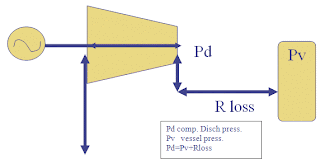Compressor Surging Under Control
Turbo compressors, either centrifugal or
axial, are the heart of many industrial processes. Often, these compressors are critical to the
operation of the plant, yet they are seldom installed with a spare unit. Surging represents a major threat to
compressors and these processes.
Surge
prevention is an important process control problem in these environments as
surging can result in costly downtime and mechanical damage to the compressors. An effective anti-surge control system is
critical for every turbo compressor.
Understanding
Surge
Many believe that surging is analogous
to cavitations in a centrifugal pump, but this is not the case. Surging is defined as a self oscillation of the
discharge pressure and flow rate, including a flow reversal. Every centrifugal or axial compressor has a
characteristic combination of maximum head and minimum flow. Beyond this point, surging will occur. During surging, a flow reversal is often accompanied
by a pressure drop.
Surging is best illustrated by observing
the movement of the compressor operating point along its characteristic curve
as shown in Figure 1
Fig 1
Development
of the Surge Cycle
Fig 2
Consider a compressor system as shown in
Figure 2. The discharge pressure is
marked Pd and the downstream vessel pressure is Pv.
Fig 3
Now, referencing Figure 3, assume that
the system is operating at steady state at Point D. If the demand for gas is reduced, the
operating point will move toward Point A, the surge point. If the load is reduced enough, the compressor
operating point will cross Point A.
Beyond Point A, the compressor loses the ability to increase the
discharge pressure such that Pd will become less than Pv. This is the flow reversal observed during
surging. The operating point will then
jump to Point B.
Point B is not a stable operating
point. When the flow reversal occurs,
the discharge pressure drops. This
forces the operating point to move from Point B to Point C. At Point C, the flow rate is insufficient to
build the necessary pressure to return to Point A. Thus, the operating point moves to Point D
where the flow rate is in excess the load demanded and the pressure builds
until Point A is finally reached. This
completes a single surge cycle. The next
cycle begins again with another flow reversal and the process repeats until an
external force breaks the surge cycle.
Consequences
of Surging
1.
Rapid flow and pressure oscillations cause process instabilities
2.
Rising temperatures inside the compressor
3.
Tripping of the compressor
4.
Mechanical damage
Mechanical
damage can include:
Radial bearing load during the initial
phase of surging. A side load is placed
on the rotor which acts perpendicular to the axis.
Thrust bearing load due to loading and
unloading.
Seal rubbing
Stationary and rotating part contact if
thrust bearing is overloaded.
Anti-Surge
Control
The only way to prevent surging is to
recycle or blow down a portion of the flow to keep the compressor away from its
surge limit. Thus, the control system
must be able to accurately determine the compressor's operating point as to
provide adequate, but not excessive, recycle flow.
A Surge Limit Line (SLL) is the line
connecting the various surge points of a compressor at varying RPMs. The set point of the anti-surge controller is
represented on the compressor map shown in Figure 4 by a line which runs
parallel to the surge limit line. This
line is called the Surge Controller Line (SCL).
The controller is then able to calculate the deviation from the
operating point to the SCL.
Fig 4
The compressor surge limit is not fixed
with respect to any one measured variable such as compression ratio or pressure
drop across the flow meter. Instead, it is a complex function that is dependent
on the gas composition, RPM, suction temperature, and pressure. A closed loop PI controller would be unable
to prevent surge during large or fast disturbances. Therefore, such a controller would be unable
to stop surge. Rather, the controller would simply cycle the recycle valve open
and closed in response to successive surge cycles. For a PI controller to act quickly, the
"b" value would need to be high.
This would result in a decreased operating region for the compressor
when the recycle valve is closed.
Thus, an open loop control is used in
conjunction with the closed loop in an anti-surge controller. The overall configuration is shown in Figure
5. A Recycle Trip Line (RTL) is used
between the SLL and the SCL. Small or
slow disturbances are managed by the closed loop controller which keeps the
compressor operating point to the right of the RTL. For large or fast disturbances, the
compressor operating point will reach the RTL.
At this point, the open loop control will be initiated. This will add a step change which is a
function of the compressor operating point at the moment it reaches the
RTL. In this manner, the fast opening
valve will be sufficient to stop surging.
Fig 5
Adaptive gain is also used in the
anti-surge controller. When the
operating point moves quickly toward the SCL, the adaptive gain move the SCL
toward the operating point.
Anti-Surge
Valve Requirements
1.
The valve must be large enough to prevent surging under all possible
operating conditions. However, a valve
which is too oversized will result in poor control.
2.
Stroke speed - A fast stroke speed is very important.
Recommended Full Stroke Times
Size Close to Open Time Open
to Close Time
1" to 4" 1
second < 3 seconds
6" to 12" 2 seconds <
5 seconds
16" and up 3 seconds < 10 seconds
3.
Ensure adequate air supply to properly operate the valve.
4. Tubing run should be minimized to
reduce lag time.
5.
One or more volume boosters are required to ensure fast response and
equal opening and closing time.
6.
Fail position should be open





No comments:
Post a Comment